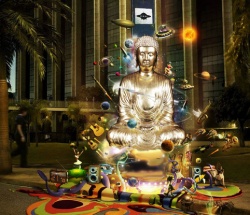Vaiḍūryanirbhāsa
On achieving Buddhahood, he (Medicine Master Buddha)became the Buddha of the eastern pure land of Vaiḍūryanirbhāsa, or "Pure Lapis Lazuli". There, he is attended to by two bodhisattvas symbolizing the light of the sun and the light of the moon respectively.
Bhaiṣajyaguru is described in the eponymous Bhaiṣajyaguruvaiḍūryaprabhārāja Sūtra (भैषज्यगुरुवैडूर्यप्रभाराज सूत्र), commonly called the Medicine Buddha Sutra, as a bodhisattva who made 12 great vows. On achieving Buddhahood, he became the Buddha of the eastern pure land of Vaiḍūryanirbhāsa (वैडूर्यनिर्भास), or "Pure Lapis Lazuli". There, he is attended to by two bodhisattvas symbolizing the light of the sun and the light of the moon respectively:
Suryaprabha (Chinese: 日光遍照菩薩; pinyin: rìguāng biànzhào púsà)
Candraprabha (Chinese: 月光遍照菩薩; pinyin: yuèguāng biànzhào púsà)
A Sanskrit manuscript of the Bhaiṣajyaguruvaiḍūryaprabhārāja Sūtra was among the textual finds at Gilgit, Pakistan, attesting to the popularity of Bhaiṣajyaguru in the ancient northwest Indian kingdom of Gandhāra. The manuscripts in this find are dated before the 7th century, and are written in the upright Gupta script
</poem>
